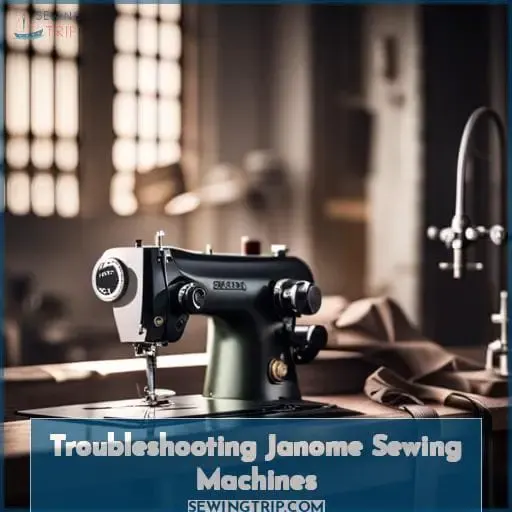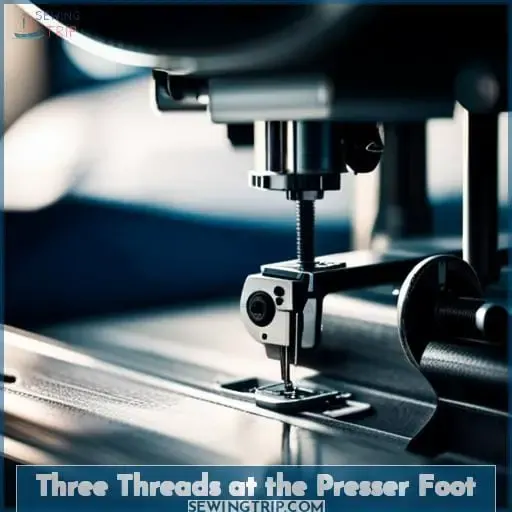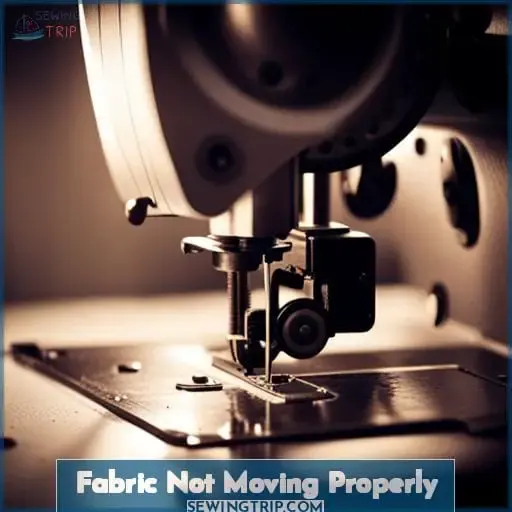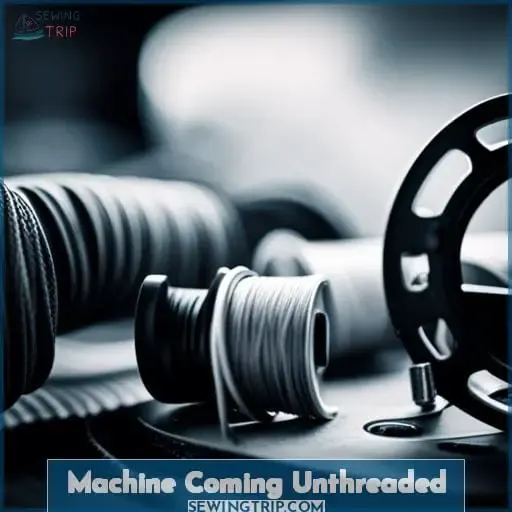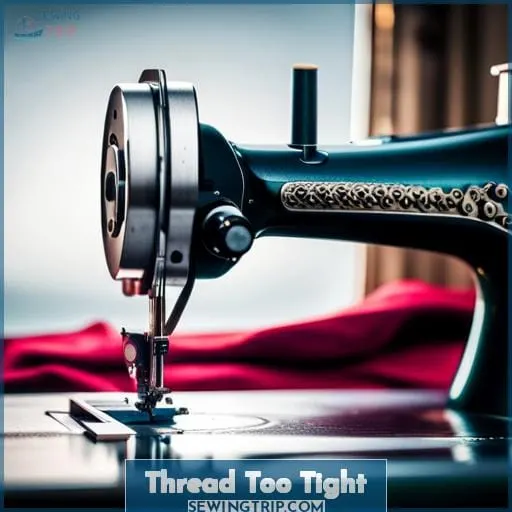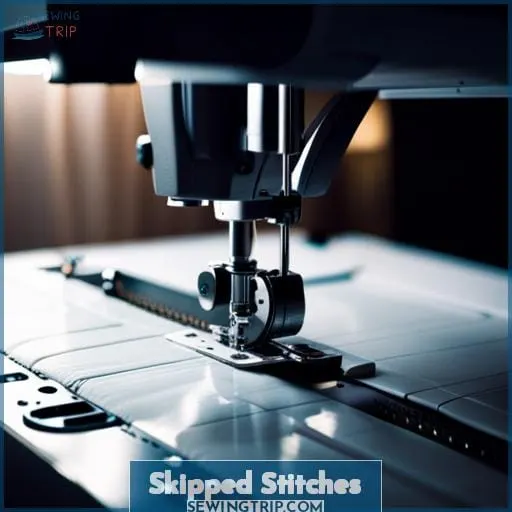This site is supported by our readers. We may earn a commission, at no cost to you, if you purchase through links.
 You know that feeling when you’re driving down the road and everything is running smoothly – the engine is purring, the wheels are gliding, you’ve got your favorite tunes playing? Sewing can feel just like that, when you and your machine are totally in sync.
You know that feeling when you’re driving down the road and everything is running smoothly – the engine is purring, the wheels are gliding, you’ve got your favorite tunes playing? Sewing can feel just like that, when you and your machine are totally in sync.
But then you hit a pothole. The ride gets bumpy, the engine starts sputtering, and you’ve lost the groove.
Sewing mishaps can throw off your sewing mojo too. But don’t worry – with a few simple troubleshooting tips, you can get your Janome machine humming again.
Double check your threading, swap out the needle, adjust the tension. Little adjustments get things back on track, just like carefully navigating around that pothole.
With some TLC your machine will be purring through projects in no time, bringing back that smooth sewing satisfaction. So next time you hit a snag, don’t sweat it. Just break out your toolbox, and you’ll be cruising along again before you know it.
Table Of Contents
Key Takeaways
- Check that the sewing machine is threaded properly, including the upper thread and bobbin thread.
- Consider changing the needle if there are problems like skipped stitches. The needle may be dull or the wrong type for the fabric being sewn.
- Adjust the thread tension if needed to prevent loose or too tight stitches. The tension should be balanced between the upper and lower threads.
- Perform regular maintenance such as cleaning and lubricating which helps prevent problems and ensures smooth operation of the sewing machine.
Troubleshooting Janome Sewing Machines
While threading your Janome, make sure the take-up lever’s raised and double-check for any thread jams that could prevent fabric from moving. When sewing over thick seams, try a new needle specifically for heavy fabrics or install the grooved quarter-inch foot designed to help layers glide smoothly.
Read your manual, watch tutorials, experiment with needles and feet to find the right combo for your project. Machine adjustments and swapping parts can prevent skipped stitches, loose threads, overly tight tension.
With patience and persistence troubleshooting, your Janome can handle most sewing challenges.
Thick seams don’t have to slow your sewing progress.
Three Threads at the Presser Foot
If three threads show at the presser foot, you’re to check the take-up lever and raise it before lowering the presser foot again. This common sewing machine issue signals improper thread tension. Before rethreading completely, first release the take-up lever to its highest position.
This gives the top thread adequate slack when the presser foot lowers onto fabric. Raising the presser foot also eliminates downward tension letting stitches form correctly.
Your sewing machine needs regular maintenance like cleaning lint and oiling to prevent thread jams. Adjusting tension settings prevents loose or tight stitches. Troubleshooting solutions keep your machine happily stitching.
With some basic care, you can solve common issues like too many threads, skipped stitches, or fabric not feeding.
Fabric Not Moving Properly
Ensure your presser foot’s down and check for thread jams. If your fabric isn’t moving properly through the machine, there are a few key troubleshooting tips to try:
- Swap your needle – a bent, dull, or wrong sized needle can hinder fabric feed. Try a new Sharp needle matched to your fabric weight.
- Add interfacing – interfacing adds body and can help fabrics glide smoothly under the foot.
- Adjust your tension – too tight can restrict movement. Loosen upper tension slightly.
- Slow it down – reduce sewing speed so the feed dogs can grip and advance the fabric.
- Check for debris – bits of thread or lint can impede progress. Clean race hook and feed dogs.
With some adjustments, you’ll have your project sewing smoothly again. Don’t forget your machine’s manual for specialized troubleshooting!
Machine Coming Unthreaded
You’d be surprised that up to 50% of sewing machine issues come from improper threading. To stop your machine from unthreading mid-project, pay attention to thread length and path. Make sure you have about 6 inches of thread trailing the spool and that the thread follows the guide holes correctly.
Put the take-up lever at its highest point when threading, then lower it before you start sewing.
Double check your machine’s manual for the proper threading order. A bit of troubleshooting saves frustration.
Proper thread length and routing prevents unthreading mishaps.
Loose and Loopy Stitches
Get better stitching by rethreading both the top and bobbin and checking your tension dial. Loose, loopy stitches happen when the tension’s off–double-check your thread’s along the right path. Make sure your bobbin’s wound properly and inserted correctly too. Try a new needle matched to your fabric weight.
Adjust the top tension dial if needed until you get smooth, even stitches. Finding the sweet spot takes some trial and error, but it’s worth it for quality stitching. You’ve got this! Proper thread tension prevents messy loops and helps your machine sew its best.
Thread Too Tight
Check with your Janome for the thread tension being too tight, making the stitches uneven.
- Check your machine’s tension setting and thread path to ensure everything looks correct.
- Try a different spool of thread – some thread types have more stretch than others.
- Make sure your bobbin is wound smoothly and evenly.
- Play around with customizing your stitch length and width to find the sweet spot.
When your thread tension is too tight on a Janome machine, the first things to check are your tension adjustment, the type of thread you’re using, how your bobbin is wound, and your stitch settings. Balanced tension takes some trial and error like Goldilocks tasting bowls of porridge.
Skipped Stitches
Replacing the needle with a sharp one can prevent skipped stitches. As you troubleshoot stitch quality issues, first try a new needle matched to your project’s fabric weight and type. The wrong needle is often the culprit behind skipped stitches. Check your manual for the right needle type and size.
Change your needle frequently to keep stitches smooth. Proper bobbin tension also prevents skipped stitches, so check both top thread and bobbin threading. When troubleshooting, isolate variables to pinpoint the root cause. With the right needles, quality thread, and properly set tensions, your machine should sew skipped-stitch-free.
Consistent stitch formation results from addressing each element in your sewing system.
Thick Layers an Issue on Janome 7700
Let’s tackle this Janome 7700 thick layer challenge together. Swapping the needle, adding specialty presser feet, and inserting interfacing can help conquer skipped stitches when sewing multiple fabric layers or bulky seams.
Try Different Needle
You should try swapping in a new needle when skips happen because a dull point just won’t do. Different needles are needed for different fabrics – universal needles work for most, but thick layers need stronger needles.
Stitching happiness comes from using the right tools, so keep trying until your machine sews smoothly.
New Quarter Inch Foot
Try the new quarter inch foot with the groove to help get over those thick seams. As a sewing machine instructor, I know the frustration of tricky layers. But many users find the groove on this foot makes all the difference for challenging seams without extra tools.
Add Interfacing
Adding a layer of interfacing can symbolically strengthen your resolve to conquer those frustratingly thick seams. Interfacing provides extra support, allowing your Janome to sew multiple fabric layers smoothly.
Avoid bulky interfacing and pre-shrink your fabrics. Use a roller foot, tissue paper, or tear-away stabilizer for slippery fabrics.
Use the right needle. A size 16 denim needle can really help punch through heavy fabrics and seams.
Play with your thread tension. Loosen up the top tension a bit when sewing multiple layers.
Use quality interfacing. Good interfacing can stabilize your fabric and support the stitches.
Engage the knee lift to raise the presser foot when pivoting or crossing seams. This gives the layers room to move.
Slow it down. Reduce your sewing speed so the machine isn’t forced to power through quickly.
Invest in specialty presser feet if needed, like a quilting or roller foot.
Be patient and keep trying adjustments – you’ll get the hang of it! The Janome 7700 is extremely capable.
Conclusion
Indeed, almost any annoyance or frustration with a Janome sewing machine can be resolved. While layered quilting or thick fabrics may seem impassable, with a few adjustments, you can tackle any sewing project with ease.
Whether there is an issue with threading, tension, movement, or stitches, the right tools and know-how empower you to troubleshoot. A new needle, upgraded foot, or interfacing provides simple solutions for conquering thick seams on the Janome 7700.
So embrace the capabilities of your Janome with confidence. With just a bit of troubleshooting, you’ll be stitching beautiful creations in no time.

